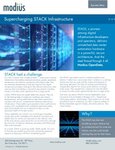At some point, every organization will need to replace their DCIM software. Whether your current solution has been discontinued or you’re simply looking for a newer, more cost-effective, and reliable solution to keep up with customer demands, the replacement process can seem daunting. However, the reward is greater than the risk. Outdated or discontinued software simply cannot keep up with the needs of a modern data center.
Today, the responsibilities of a data center operator expand far beyond managing power, climate, and space. They are also responsible for selecting new hardware platforms, enabling complete virtualization and adaptation of suitable cloud concepts, managing network capacities, and introducing software-defined networking or network fabrics into the technical landscape. The modern data center is a complex ecosystem, one that demands the right software to drive efficient processes, automation, and complete transparency.
The ideal DCIM solution should document and manage the physical and logical levels of a data center all the way to virtualization, including all cabling and network aspects and services. In particular, a solution that houses data for multiple departments within one central system, rather than multiple small, independent applications, is recommended. This centralized approach will ensure data integrity throughout the entire organization. To maintain quality and consistency, automatic plausibility checks to synchronize the data are also required.
Such holistic management will allow all documentation to be analyzed faster as the required data is readily available and interrelated. Universal access to a single source of quality data is also instrumental in making remote work possible, enabling cross-site collaboration across an enterprise, and supporting decision-making by providing direct access to business-related information such as maintenance agreements.
Finding a long-term, sustainable DCIM solution
Once you’ve decided to replace your current DCIM tool, you’ll need to evaluate solutions. Here are the top features to look for in a long-term, sustainable DCIM solution:
Standard formats. Data integration can be simplified when import templates for standard formats are available and coupled with a comprehensive API that contains thousands of function calls and numerous additional standard interfaces such as ActiveDirectory, vCenter or SCCM. An additional benefit is that all data will be in a uniform format moving forward.
Easy system configuration. The beauty of standard software is that it can offer numerous configuration possibilities. From the management of symbols to core data and data encyclopedias, centralized administration provides the opportunity to adapt the system to your specific requirements. Even changing attributed names and adding custom attributes or object types can be easily accomplished with the right system.
Consistent planning functions. Consistency is key to optimization, particularly when it comes to planning changes. It enables smooth and accurate change processes and proper management of assembly, conversion, and expansion activity. Automatically generated work orders based on planning will support the implementation and simplify collaboration with external service providers.
Flexible processes. Software with an efficient workflow engine can reduce manual workloads by as much as 60%. Look for pre-defined task modules and graphic modeling capabilities which will provide the flexibility to adapt processes as needed. These features should be provided without any programming effort.
Application layer documentation. A modern DCIM tool must control all layers of the stack relating to ITC equipment, from the physical and logical all the way up to virtualization and applications. Restricting your management to space, power, and cooling is insufficient. Only software powered by a comprehensive data model can provide full information, from the server to the host to the operating system and, ultimately, the application, to fulfil this requirement.
Vendor agnostic. Many hardware manufacturers offer DCIM systems to complement their products. The drawback of using these systems is that they are specialized for a single provider. A software tool will likely be used for 10-15 years, yet most IT equipment has a lifespan of only about five years. This is a significant mismatch. Therefore, it’s critical for software, especially DCIM software, to be independent of a hardware manufacturer. As a data center keeps the entire businesses running, it needs to be managed by a future-proof DCIM system that supports all vendors.
Five Steps to Migrating to a New Solution
If you have concerns about a migration taking too long, draining your budget, or impacting ongoing operations, you are not alone. Proper planning is key to ensure a smooth transition. The following best practices will help your organization migrate to a new solution seamlessly and without service interruptions.
- First, analyze the existing system landscape, data, basic business processes that use the data, data groups, and dependencies. Identifying how the migration will affect other third-party systems and business processes is important to avoid service interruptions.
- As a result of the analysis, you will have a complete overview of the system infrastructure. The data to be transferred can now be identified and used as the basis for creating a coordinated data migration milestone plan.
- Next, detailed specification of the data migration, including all technical aspects, the migration technology to be used, and the data format, should be laid out. Individual attributes can be assigned to fields through data mapping while necessary transformations, the enrichment of data records by information from third-party systems, and data cleansing, can be defined.
- The prerequisites for the start of the implementation phase, such as the transfer of test data or a complete data dump of the source system, can now be produced. Full specification of data migration parameters, the technical design for the implementation of data migration, the establishment of prerequisites for implementing the data migration, and the acceptance and exclusion criteria for data migration should be prepared.
Finally, the data migration can begin. Progress should be continuously monitored, and quality assurance checks should be made on the transferred data into the target system. A migration report that details the migration statistics should be created and a random validation of the data in the new system should be performed to confirm a positive outcome.





